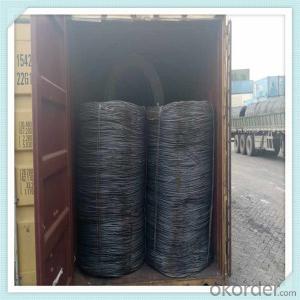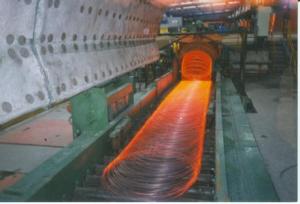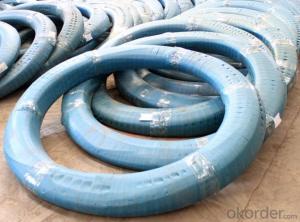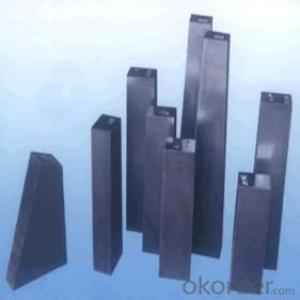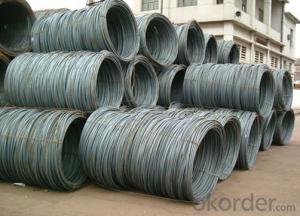Hot dip steel wire rod in different grade and size
- Loading Port:
- Tianjin
- Payment Terms:
- TT OR LC
- Min Order Qty:
- 100 m.t.
- Supply Capability:
- 19823 m.t./month
OKorder Service Pledge
OKorder Financial Service
You Might Also Like
Specification
Wire rod is a rolled alloy or nonalloy steel product, produced from a semi (e.g. bloom) and having a round,
rectangular or other cross-section. Particularly fine cross-sections may be achieved by subsequent cold
forming (drawing). Wire rod is wound into coils and transported in this form.
Features
1、Pure steel quality, stable chemical contents, small tolerance.
2、Constant Quality, good drawing performance.
3、High dimension accuracy degree, accuracy degree of Level C up to 80%, smooth surface, less scale,
easy to be pickled.
4、Automatic bundling with 4 lines by Machine in tidy and good looks
5、Big high quality percentage, small coil percentage, and heavy coil weight for Hard Coil.
6、High sorbitizing percentage.
Product Description :
Standard | AISI, ASTM, BS, DIN, GB, JIS |
Material/steel grade | Q195-Q235,SAE1006B,SAE1006CR, SAE1008B, SAE1008CR, SAE1010B, SAE1018B, or according to customers requirements |
Wire Gauge | 5.5-12mm |
Coil weight | 1.8-2.1mts |
MOQ | 25MT |
Delivery Time | 15-30 days after receipt of L/C or deposit by T/T |
Packing | In coil and load in container, if large quantity, by bulk vessel; Can be packed as customers' special requirements |
Payment terms | 1).100% irrevocable L/C at sight. 2).30% T/T prepaid and the balance against the copy of B/L. 3).30% T/T prepaid and the balance against L/C |
Application | widely used in machinery parts, manufacturing industry, electronics industry, metal tools and others |

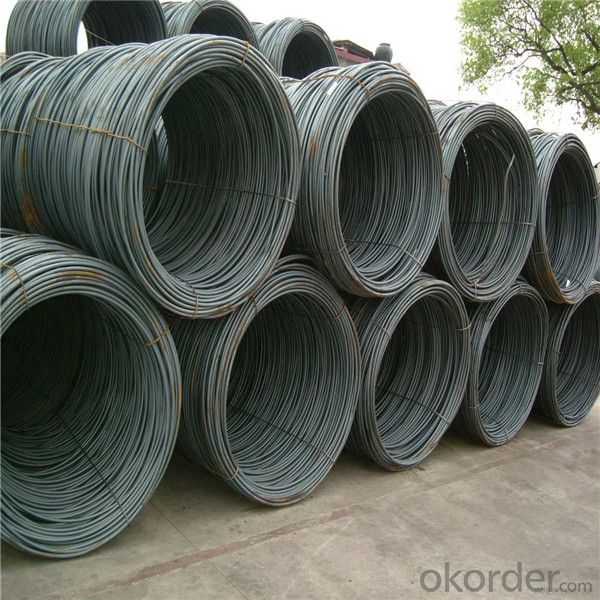
Application :
It generally used in braiding the hose for bathing product and machinery. With it
good flexibility, resistant to high temperature and resistant to corrosion, it
used widely in many industries.
Packing :
Hot-rolled wire rod is held in a unit with at least four steel straps in the
transverse direction and transported and stored without further packaging.
Before
the steel strapping is applied, the wire rod must be sufficiently compressed.
The strapping is fixed in the transverse direction with a single circumferential
strap so that the strapping does not slip and cause the coil to come apart.


Our service:
(1) We cooperate with famous factories with advanced equipment and well trained workers.
(2) We can provide factory price with trading company service.
(3) We continuously work on the improvement of our processes, guaranteeing
consistently high standards of quality to keep none compensation.
(4) We guarantee 24 hours response and 48 hours solution providing service.
(5) We accept small order quantity before formal cooperation.
(6) We deliver the agreed quality at the agreed time, reacting to changes in
customer wishes in a flexible way.
(7) Due to our volume and selling power, we have excellent freight rates with
shipping lines.
(8) We strive to always be fair and honest in our dealings with customers.
(9) We strive to work together with customers to achieve much more than we can
achieve alone.
(10) Through our passion and commitment we aim to be a market leader in all our
key markets. To maintain our position as market leader we must continue to add
value in all that we do.
FAQ:
1.Q: What's your MOQ(minimum order quantity)?
A: One full container, mixed acceptable .
2. Q: What's your packing methods?
A: Packed in bundle or bulk ..
3. Q: How can I buy CNBM products in my country?
A:Please send us an inquiry or email ,we will reply to you if there is distributor in your country
4. Q: Can we visit your factory?
A: Warmly welcome. Once we have your schedule, we will arrange the
professional sales team to follow up your case.
5. Q: How long does it take to get the product if i place an order?
A:With the process of your requirements,we will pack and deliver in 3
-7 days. If it is by sea shipment,it will take 15-45 days depending on different locations
- Q: How is steel wire rod used in the manufacturing of wire for shipbuilding applications?
- Steel wire rod is used in the manufacturing of wire for shipbuilding applications as it serves as the primary raw material for producing high-quality wires. This wire rod is first drawn through a series of dies to reduce its diameter and increase its length, resulting in a thinner and longer wire. This wire is then further processed and fabricated into various components such as cables, ropes, and structural elements used in shipbuilding. The strength and durability of steel wire rod make it an ideal material for withstanding the harsh marine environment and ensuring the safety and reliability of ships.
- Q: What are the common industry exhibitions for steel wire rod?
- Some common industry exhibitions for steel wire rod include Wire & Cable India, International Wire & Cable Fair, Wire China, and Wire Southeast Asia.
- Q: What are the different quality control measures for steel wire rod production?
- There are several quality control measures implemented during steel wire rod production. These include regular inspection of the raw materials used, such as the steel billets, to ensure they meet the required specifications. In-process inspections are conducted at various stages of production to check for any defects or deviations from the desired dimensions and chemical composition. Testing is also done to assess the mechanical properties of the wire rod, including tensile strength, elongation, and hardness. Additionally, surface inspections are carried out to detect any surface defects or imperfections. Overall, these quality control measures help to ensure the production of high-quality steel wire rods that meet industry standards and customer requirements.
- Q: How is steel wire rod used in the manufacturing of wire harnesses?
- Steel wire rod is used in the manufacturing of wire harnesses as it serves as the primary material for the conductive wires within the harness. The wire rod is first drawn into the desired diameter and then processed further to remove any impurities or surface defects. These high-quality wires are then twisted, braided, or insulated to create the necessary configuration for the wire harness, providing the required strength, flexibility, and electrical conductivity. Overall, steel wire rod plays a crucial role in ensuring the durability and performance of wire harnesses in various industries, including automotive, aerospace, and electronics.
- Q: How is steel wire rod used in the manufacturing of wire forms for display racks?
- The manufacturing of wire forms for display racks heavily relies on steel wire rod. This component plays a vital role as the raw material that is subjected to a range of manufacturing processes in order to create wire forms with precise shapes and sizes. The initial step involves carefully selecting the appropriate quality and diameter of steel wire rod. This selection process is dependent on the desired strength, durability, and flexibility of the wire forms. Once the suitable steel wire rod has been chosen, it is fed into a wire drawing machine. In this machine, the steel wire rod is pulled through a series of dies, effectively reducing its diameter and increasing its length. Once the wire has been successfully drawn to the desired size, it proceeds to undergo a series of shaping and bending processes. These processes may entail the utilization of specialized machines or tools to bend the wire into specific angles, curves, or shapes that are required for the display racks. Additionally, the wire may also be cut into specific lengths as per the design requirements. In order to retain the desired shape and structure of the wire forms, further processes such as heat treatment or galvanization may be carried out. Heat treatment serves to strengthen the wire forms, making them more resistant to bending or deforming when subjected to heavy loads. On the other hand, galvanization entails applying a protective layer of zinc onto the wire forms to safeguard against corrosion, thereby enhancing their lifespan. Once the wire forms have been shaped, bent, and treated, they are now ready to be assembled into the display racks. These wire forms can be employed for various purposes within the display rack industry, such as forming shelves, hooks, or frames. The versatility of steel wire rod allows for the production of wire forms in different designs, sizes, and load capacities, thus enabling them to meet the specific requirements of display rack applications. To summarize, the manufacturing process of wire forms for display racks heavily relies on steel wire rod. This crucial component undergoes a range of processes including wire drawing, shaping, bending, and treatment to produce wire forms with specific shapes, sizes, strength, and durability. Once assembled into display racks, these wire forms provide a robust and adaptable solution for showcasing products.
- Q: How is steel wire rod used in the manufacturing of cables?
- Steel wire rod is used in the manufacturing of cables as the primary material for the inner core. It provides strength, durability, and conductivity, making it suitable for transmitting electrical signals or supporting heavy loads in various applications such as power cables, telecommunications cables, and elevator cables. Additionally, steel wire rod is often coated or insulated to enhance its performance and protect against corrosion, ensuring the longevity and reliability of the cables.
- Q: How is steel wire rod cooled after the rolling process?
- Steel wire rod undergoes various cooling methods after the rolling process to achieve desired properties and prevent distortion or damage. Air cooling is a common method where hot wire rods are gradually cooled by exposure to ambient air. This allows for controlled cooling and uniform temperature distribution. Another method is water cooling, which involves spraying or immersing the wire rods in water. Water cooling is faster and more efficient due to its superior heat transfer properties. It results in improved mechanical properties and surface quality. In certain cases, accelerated cooling is utilized using specialized cooling beds or water sprays. This method involves forcefully reducing the wire rod's temperature by applying cool air or water onto its surface. Accelerated cooling is particularly beneficial for achieving specific mechanical properties or enhancing the wire rod's microstructure. Controlled cooling processes are also employed, such as controlled cooling in a furnace or cooling in a quenching tank. These methods involve placing the wire rods in a controlled environment, like a furnace with a controlled atmosphere or a quenching tank filled with a specific cooling medium. These controlled cooling processes enable precise temperature and cooling rate control, resulting in the desired material properties and microstructure. Ultimately, the cooling process after the rolling of steel wire rods significantly impacts their final properties and quality. The choice of cooling method depends on factors such as the desired properties, production capacity, and available resources.
- Q: Can steel wire rod be used for reinforcement purposes?
- Indeed, reinforcement purposes can be fulfilled by steel wire rod. Concrete structures, such as buildings, bridges, and highways, frequently rely on steel wire rod for reinforcement. This is due to the remarkable tensile strength of steel, enabling it to endure substantial loads and stresses. When incorporated into concrete, steel wire rod effectively heightens the overall strength and longevity of the structure. Additionally, it safeguards against cracking and enhances structural integrity. Given its exceptional mechanical properties and capacity to enhance the performance of concrete structures, the construction industry commonly utilizes steel wire rod for reinforcement objectives.
- Q: What are the major opportunities for companies in the steel wire rod market?
- Some major opportunities for companies in the steel wire rod market include expanding into emerging economies with growing construction and infrastructure sectors, diversifying product offerings to cater to various industries such as automotive and aerospace, embracing technological advancements to improve production efficiency and quality, and exploring sustainable practices to meet the growing demand for environmentally friendly steel products.
- Q: What are the main factors affecting the market alliances of steel wire rod?
- The main factors affecting the market alliances of steel wire rod can include supply and demand dynamics, price fluctuations, competition within the industry, technological advancements, regulatory policies, and geopolitical factors.
Send your message to us
Hot dip steel wire rod in different grade and size
- Loading Port:
- Tianjin
- Payment Terms:
- TT OR LC
- Min Order Qty:
- 100 m.t.
- Supply Capability:
- 19823 m.t./month
OKorder Service Pledge
OKorder Financial Service
Similar products
Hot products
Hot Searches
Related keywords
